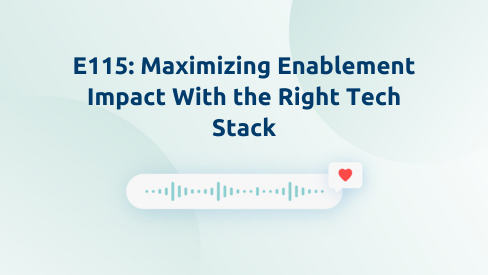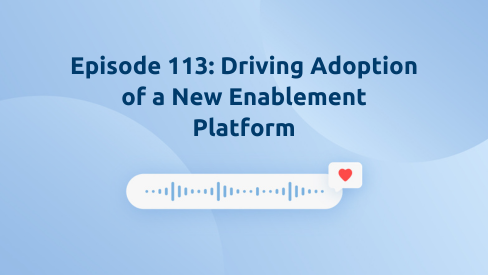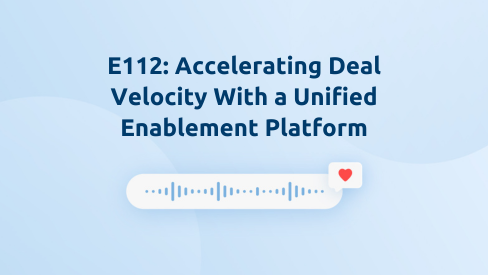Research from G2 found that sales enablement influences sales; 76% of businesses report a rise in revenues of 6% to 20%. So how can you drive business impact through sales enablement?
Shawnna Sumaoang: Hi and welcome to the Win Win Podcast. I’m your host, Shawnna Sumaoang. Join us as we dive into changing trends in the workplace and how to navigate them successfully. Here to discuss this topic is Doga Butler, global sales enablement and processes manager, and TD Haines, program manager of enablement strategy at Stripe. Thanks for joining, Doga and TD! I’d love for you to tell us about yourself, your background, and your role. Doga, if we could start with you.
Doga Butler: Thank you. We’re very happy to be here. I worked in sales for many years and found my real passion in sales enablement. I genuinely enjoy helping other humans. In my role, I get to help sellers become more efficient and effective in their roles. As you mentioned, I’m currently working at Stripe as the global processes manager within the sales enablement team.
SS: Wonderful. We’re excited to have you here. And TD, how about you?
TD Haines: Yeah, thanks for having us. My career has kind of gone through a lot of different industries, from education and consulting to sales enablement. If there’s a steel thread that runs through them all, it’s just helping others make a measured impact. As you said, I am currently the program manager for sales enablement strategy. Our team has a focus on things like the data, the tech, change management, processes, and learning logistics.
SS: I love that. Well, I’m excited to have both of you here on the podcast today. To start us off, tell us a little bit about your enablement strategy. What are some of your top focus areas for enablement, and how do these align with key business priorities? TD, if I could pass this question to you, I’d love to hear your perspective on this.
TDH: I think for like right now, we’re really focused on how we set up enablement to be adaptable, actionable, simple. We really measure what matters. Regardless of how the business parties shift or what they are, we’re able to align in a clear, tactically documented way.
Sellers have a lot that’s going on. Their time is very valuable and requested by a lot of different priorities. Really, our focus is just the time that we do get from sellers. Whether it’s on content or training, how do we maximize that time? Really we want to make it count, and that requires a process of frequent prioritization.
SS: Absolutely. TD, on LinkedIn you share that the true value of enablement comes from being able to answer the question, ‘How do we know?’ Tell us more about this. How does this influence how you shape your enablement strategy?
TDH: The ‘how do we know’ question really stems from taking the human-centered approach. There are lots of different phases of enablement design. If you look at The Six Disciplines of Breakthrough Learning, which is a great book, there are different moments throughout designing enablement. The ‘how do we know’ unlocks kind of in each of those phases.
If someone were to say, we need to do training on discovery, then the ‘how do we know’ question expands into, well, ‘how do we know’ we need to do training on discovery? ‘How do we know’ what the challenges are? ‘How do we know’ what the gaps are? ‘How do we know’ when we get it right? It really just unlocks those different pieces and makes it so that it’s something that we can make a fully measured impact with.
SS: I love that. Taking a couple of steps back, I’d love to understand the evolution of your enablement strategy. Prior to Highspot, what were some of the problems that were facing your business, Doga?
DB: In earlier stages of a company, sales content is mostly created by sellers and it tends to live in many different locations. Decentralized content creation creates risks around inconsistent messaging and brand adherence. The lack of a centralized platform to store and organize sales content results in inefficiencies and difficulties in finding the right resources to support the selling efforts. In general, companies lack insights around content usage internally, and to TD’s question, we don’t know if the content we have works.
SS: That’s always a challenge, especially in early-stage organizations and I love that you guys have matured quite a bit at Stripe. Since implementing Highspot, how have you overcome some of these challenges?
DB: The first step for getting to an organized content strategy is centralizing it in one location. When you centralize content, it becomes easier to do a content gap analysis. It highlights what you have, what’s the state of your existing content, and where the gaps are. It also makes it easier for sellers to find content, so they don’t need to go on a scavenger hunt each time they need to prepare for a user conversation. It allows them to spend more time selling rather than looking for content or building it themselves.
Implementing a platform, such as Highspot, gives you strong analytics on how content is used so you can make data-driven decisions to improve your content strategy. You can, at the click of a button, see which content gets used. It is, in my opinion, quite shocking to see how much of it gets used, or doesn’t get used. If nothing else, by optimizing your content creation to assets that actually get used, you save many hours for your publisher teams.
Highspot makes content governance easy as well. It is very easy to set governance rules around content freshness and review cycles, as you can imagine, especially in high-growth environments where change is a constant. Having a platform that makes content management systematic ensures that sellers have the right content and messaging each and every time.
Last but not least, Highspot’s machine learning-supported search function not only reduces time spent looking for content but also enables us to see what those search terms are so we can focus our efforts on creating the right collateral for them.
SS: I love that. I think you hit on quite a few key points, but absolutely around seller productivity and really making sure that they have as much time as possible to focus on selling.
DB: I’d like to also mention that we utilize Highspot’s services team for ongoing support and governance. The team’s support has been invaluable for our success. Over the past two years, they have become an extension of our team. They keep us honest by constantly keeping us informed on new features and suggesting tactics to improve our platform utilization. The team also provides further benchmark data so we can measure our platform utilization against other platform users and improve on an ongoing basis.
SS: I love that. Now, you have both garnered a 78 percent adoption rate of Highspot across your company, which is fantastic. What are your best practices for driving the adoption of the platform and your enablement programs? Doga, if I could pass this back to you, I’d love to hear from you first, and then TD, I’d like your perspective as well.
DB: We have 78 percent of the entire population that has access to the platform, but our seller adoption just hit 98 percent last month. The remaining 2 percent are the people on leave, hopefully, otherwise, I’ll be chasing them down. I think any company looking to increase adoption would want to leverage a few tactics.
Firstly, you want to ensure that your content repository is the single source of truth for sales content. They know where they need to go. Another tactic that we found helpful is ensuring that all communication lands on Highspot. The consistency we find over time teaches everyone that this is the place to go and look for content. If it doesn’t exist in Highspot, it doesn’t exist.
Lastly, we utilize spot policies. Each asset is tagged with at least one list item. Each asset has an assigned feedback owner and an expiry date. This ensures that our content is fresh and accurate at all times. Sales teams can trust that the content they find eventually is reliable and it’s good to present to a potential customer. It builds trust so they keep on coming back.
TDH: Just to add to those. If you really want to help people make an impact, then you really have to measure it. Take those measurements that you’re tracking, because you’re trying to make that measure impact and put them in the things that you care about, like your OKRs or your KPIs. However, if you’re reporting your enablement efforts, like your monthly or quarterly business reviews, your Highspot metric should be there as well. That creates this top-down accountability that Highspot is something that we care about and the usage of.
You get this alignment from the team and the whole organization that we care about this investment. Making the platform easy and reliable is important. Doga has a great governance policy in place. Along with the Highspot tools, you want to make sure that time spent searching is time spent not selling, so you want to make sure that search is reliable and gets the best experience it can be that means taking a proactive approach to getting unused content or outdated content out of the system because we want it to be organized, not like your kitchen junk drawer where you just kind of throw everything in. You want it to be like, you know, I know exactly what I can grab.
SS: Absolutely. You guys have done a fantastic job at that. I mean, we talked about your overall adoption scores, but you guys also have 68% well-governed content, 63% play adoption, and 90% content efficiency too. To that point about making content more findable for your reps, you guys are doing a stellar job at that. Doga, to understand how your approach to Highspot helped you influence key business results as well if I could send this one to you, that’d be great.
DB: You talked about play adoption. I just love sales plays. Firstly, because I find them very easy to build. What they say is, presentation is everything. When something is neat and easily digestible, adoption follows organic. Another reason why I love sales plays is because they come with an out-of-the-box analytics section. With a click of a button, I can see how much of our audience we reached, which sections they engage with, and where we can improve.
When it comes to governance, I mentioned the importance of utilizing spot policies earlier. We make it mandatory to tag each asset in at least one list, and there’s a feedback owner and expiry date. We also utilize global lists to ensure assets are tagged consistently. I highly recommend having your sales process stages, products, and services, regions, segments, and markets standardized by these global lists.
This again creates consistency and allows you to reorganize content in the system when you have to. Recently, for example, I created sales plays for each of our sales process stages, and it was very easy for me to map the assets for each stage. I had the content already tagged in the system, ensuring each asset has a feedback owner who is responsible for implementing the feedback received from sales teams. Reviewing the content when expiry dates are reached just brings clarity to roles and responsibilities and makes it easy to scale content management. The longest expiry date we allow currently is one year, so we ensure that each asset is reviewed at least once a year.
SS: I love those, and those are fantastic best practices for our audience. Going back to the ‘how do we know’ question we talked about earlier, how do you leverage Highspot to help answer this question and surface data on what good looks like? TD, I’d love to hear from you.
TDH: We really appreciate the data and the insights that Highspot serves up, like views and content usage. We leverage the expiry dates like Doga was talking about. There’s a lot there that we leverage and really helps us put together. The picture of what a seller is doing right throughout the system and understand how their journey with content is unraveling. When you have data like that, you can really start to evaluate the pieces. That really has a high potential impact on outcomes.
Seth Godin has this great line that says people like us do things like this, which is really about making that tribal connection for marketing. We use it in a way to almost do A/B testing. You can see people who are highly engaged versus the people who are not highly engaged yet. Then we can start to say like, well this group that’s highly engaged, what are their outcomes? This group that’s not highly engaged yet, what are their outcomes? We can draw those correlations there.
Then we can also flip it too. These are our high performers, and these are the ones who are still emerging with their performance. We can look at their usage of Highspot, and start to do things like that. It really makes it where we can draw those correlations and start looking at what are those high-yielding behaviors of our top sellers. Just using that mix of content performance and business outcomes. You can really categorize and prioritize actions to improve your content. Maybe you have something that people who use it perform really well, so that’s something you need to promote. Let’s get more people using this content, or maybe it needs to be redesigned or reevaluated. It’s just like that insight and action that you can get from the data that Highspot provides.
SS: I love that. On that point, as you gather new insights or even as business priorities change, what are your best practices for continuously evolving and optimizing your enablement strategy? Doga, I’d love to hear from you on this.
DB: We operate in a fast-growth and constantly changing environment. Continuous evaluation and optimization are at the core of our enablement strategy. Firstly, we maintain an open feedback loop with our stakeholders. Enablement councils or regional committees can be helpful forums for collecting qualitative feedback and input for changing priorities. By actively listening to feedback, we can gather valuable insights that shape our enablement strategy and initiatives.
We also leverage data and analytics from tools like Highspot to monitor the effectiveness of our enablement programs. TD gave many examples of that. By analyzing usage data, content performance, and key performance indicators, we can identify areas of improvement and make data-driven decisions on how to optimize our enablement resources and training programs.
Furthermore, we actively stay informed about industry trends and best practices in sales enablement. This involves attending conferences, participating in webinars, and podcasts, and networking with other enablement professionals. We find by staying connected to the broader enablement community, we can ensure that our strategies and approaches are always up to date and aligned with emerging trends and innovations.
SS: I love that. Last question for each of you. Why is enablement mission-critical for businesses today?
DB: Enablement is mission-critical for businesses because it is the connective tissue between your overall goals and how they are embodied in real life. We talk about the behaviors we want to observe in sellers. Enablement ensures that sales teams have the knowledge, skills, and resources they need to effectively engage with your prospect.
TDH: It’s just so fast today, right? I think businesses are experiencing that where it’s just things are moving quickly and time is a commodity. Change happens quickly. Enablement becomes a really important piece of change management. I think, traditionally, more associated with developing understanding and developing skills, but also when you think about the reinforcement function that needs to happen with change management, you’re not going to have people sit in a training or read a doc and get it the first time, especially with the amount of change the world is going through right now. Enablement is a big part of that reinforced function as well because it does align, like Doga said, to the behavior changes and support we want.
SS: Absolutely. I love that time is a commodity. I might have to steal that from you, TD. Thank you both for joining us on this podcast. This has been fantastic and I’ve enjoyed the conversation.
DB: Thank you for having us.
TDH: Thank you.
SS: Thank you for listening to this episode of the Win Win podcast. Be sure to tune in next time for more insights on how you can maximize enablement success with Highspot.





